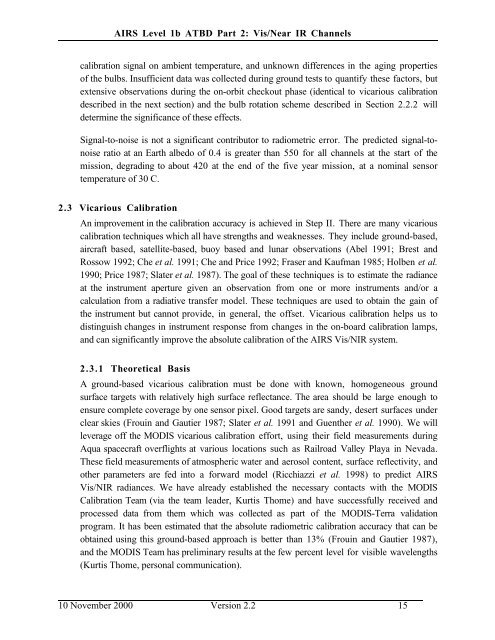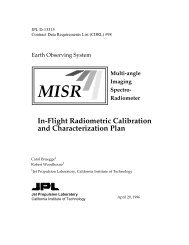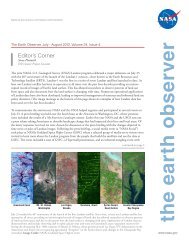AIRS Level 1B Visible/Near-Infrared Channels ATBD - NASA's Earth ...
AIRS Level 1B Visible/Near-Infrared Channels ATBD - NASA's Earth ...
AIRS Level 1B Visible/Near-Infrared Channels ATBD - NASA's Earth ...
Create successful ePaper yourself
Turn your PDF publications into a flip-book with our unique Google optimized e-Paper software.
<strong>AIRS</strong> <strong>Level</strong> 1b <strong>ATBD</strong> Part 2: Vis/<strong>Near</strong> IR <strong>Channels</strong><br />
calibration signal on ambient temperature, and unknown differences in the aging properties<br />
of the bulbs. Insufficient data was collected during ground tests to quantify these factors, but<br />
extensive observations during the on-orbit checkout phase (identical to vicarious calibration<br />
described in the next section) and the bulb rotation scheme described in Section 2.2.2 will<br />
determine the significance of these effects.<br />
Signal-to-noise is not a significant contributor to radiometric error. The predicted signal-tonoise<br />
ratio at an <strong>Earth</strong> albedo of 0.4 is greater than 550 for all channels at the start of the<br />
mission, degrading to about 420 at the end of the five year mission, at a nominal sensor<br />
temperature of 30 C.<br />
2.3 Vicarious Calibration<br />
An improvement in the calibration accuracy is achieved in Step II. There are many vicarious<br />
calibration techniques which all have strengths and weaknesses. They include ground-based,<br />
aircraft based, satellite-based, buoy based and lunar observations (Abel 1991; Brest and<br />
Rossow 1992; Che et al. 1991; Che and Price 1992; Fraser and Kaufman 1985; Holben et al.<br />
1990; Price 1987; Slater et al. 1987). The goal of these techniques is to estimate the radiance<br />
at the instrument aperture given an observation from one or more instruments and/or a<br />
calculation from a radiative transfer model. These techniques are used to obtain the gain of<br />
the instrument but cannot provide, in general, the offset. Vicarious calibration helps us to<br />
distinguish changes in instrument response from changes in the on-board calibration lamps,<br />
and can significantly improve the absolute calibration of the <strong>AIRS</strong> Vis/NIR system.<br />
2.3.1 Theoretical Basis<br />
A ground-based vicarious calibration must be done with known, homogeneous ground<br />
surface targets with relatively high surface reflectance. The area should be large enough to<br />
ensure complete coverage by one sensor pixel. Good targets are sandy, desert surfaces under<br />
clear skies (Frouin and Gautier 1987; Slater et al. 1991 and Guenther et al. 1990). We will<br />
leverage off the MODIS vicarious calibration effort, using their field measurements during<br />
Aqua spacecraft overflights at various locations such as Railroad Valley Playa in Nevada.<br />
These field measurements of atmospheric water and aerosol content, surface reflectivity, and<br />
other parameters are fed into a forward model (Ricchiazzi et al. 1998) to predict <strong>AIRS</strong><br />
Vis/NIR radiances. We have already established the necessary contacts with the MODIS<br />
Calibration Team (via the team leader, Kurtis Thome) and have successfully received and<br />
processed data from them which was collected as part of the MODIS-Terra validation<br />
program. It has been estimated that the absolute radiometric calibration accuracy that can be<br />
obtained using this ground-based approach is better than 13% (Frouin and Gautier 1987),<br />
and the MODIS Team has preliminary results at the few percent level for visible wavelengths<br />
(Kurtis Thome, personal communication).<br />
10 November 2000 Version 2.2 15







